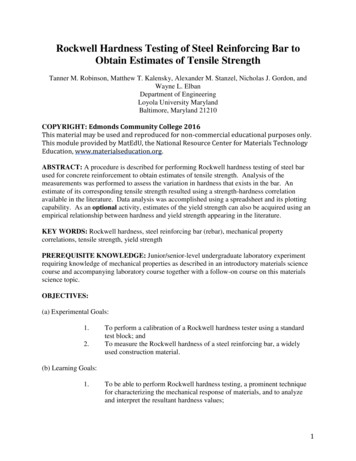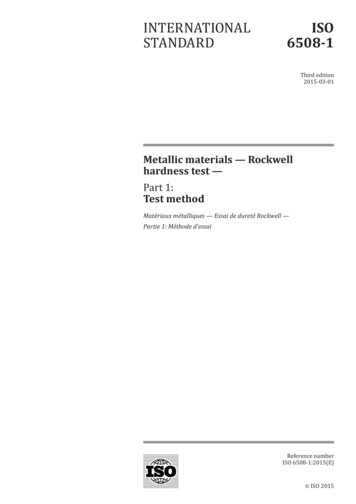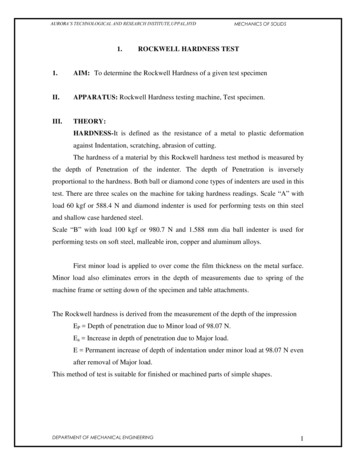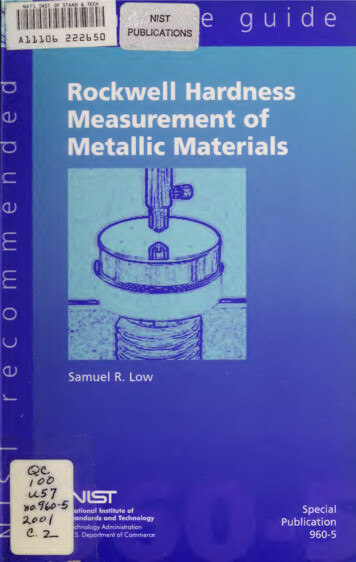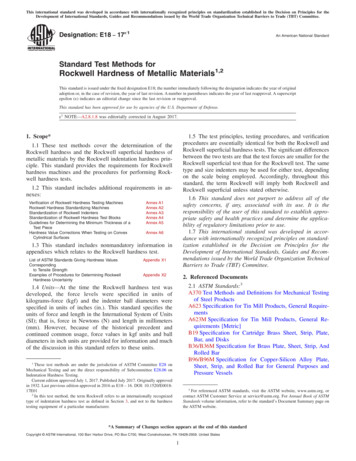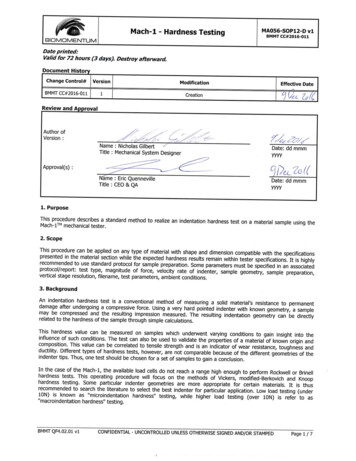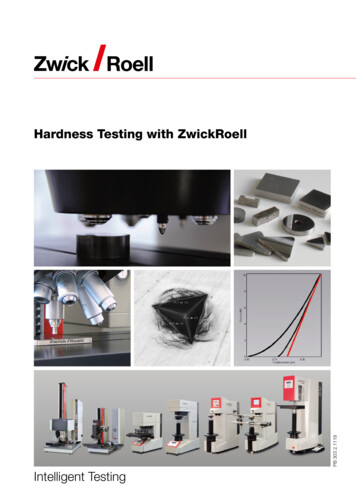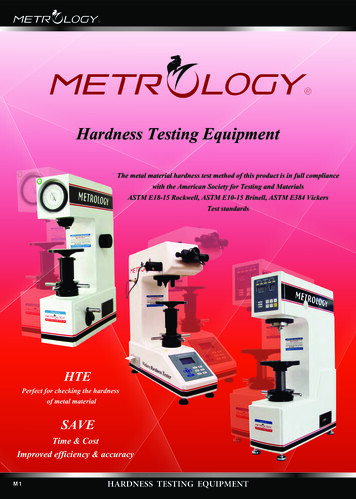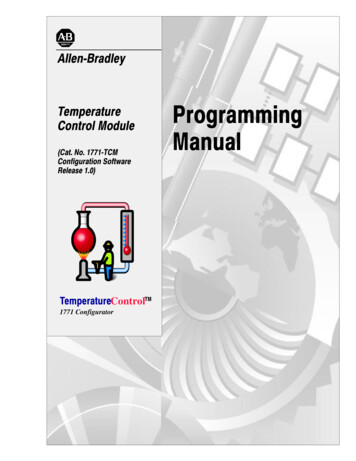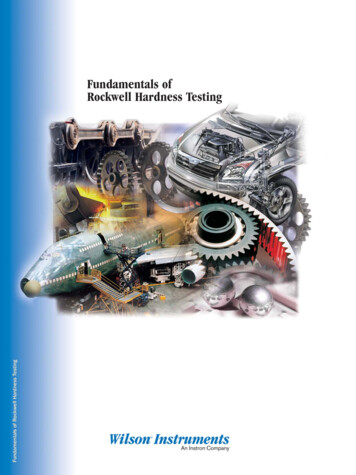
Transcription
Fundamentals of Rockwell Hardness TestingFundamentals ofRockwell Hardness Testing
Fundamentals of Rockwell Hardness TestingPrinciple of TestLike the Brinell, Vickers, Knoop, Scleroscope and Leebtests - all of which fall in the general category of indentationhardness tests - the Rockwell test is a measure of theresistance of material, specifically metals, to permanentindentation. Indentation hardness is not a fundamentalproperty of a material. However, reliable relationships havebeen established between the various tests and importantproperties of materials, such as tensile strength andmachinability. Furthermore, indentation hardness hasbecome one of the most reliable controls of the heattreatment and quality of manufactured parts. Rockwelltesting is covered by ASTM test method E 18.The Rockwell test consists of measuring the additionaldepth to which a carbide ball or Brale diamondpenetrator is forced by a heavy (major) load beyond thedepth of a previously applied light (minor) load (SET point).While all indentation hardness tests generally serve thesame purpose, each one has definite advantages that makethe test more applicable to certain types of materials andpart geometries. Brinell is used primarily on forgings andcast iron. The rebound test is used on large rolls. Vickersand Knoop tests are used on very small or thin parts andfor case depth determinations on parts such as gear toothprofiles. The Rockwell test is the most popular indentationhardness test and is used in a wide variety of applications.The Brale diamond penetrator is used for testing materialssuch as hardened steels and cemented carbides. Thecarbide ball penetrators, available with 1/16 inch,1/8 inch, 1/4 inch, and 1/2 inch diameter, are used when testingmaterials such as steel-copper alloys, aluminum and plasticsto name a few.Advantages of the Rockwell TestThere are several reasons for the popularity of the Rockwelltest. The test itself is very rapid. On a manually operatedunit, a Rockwell test takes only five to ten seconds,depending upon the size and hardness of the specimen, aswell as pre-load and dwell time. Also, the indentation isextremely small and usually does not need to be removedby machining, making this a non-destructive test. ARockwell C scale test on hardened steel, for example,penetrates to a depth of approximately 0.0035 inch, withthe diameter of the indentation only 0.019 inch, which isbarely visible. The Rockwell test is applicable to a widerange of part sizes. Sheet metal as thin as 0.006 inch canbe tested on the Rockwell superficial tester, and as long asthe surface area is large enough, there is no actual limitationto the size of your specimen. The Rockwell test is based onmeasurement of the depth of penetration with the hardnessnumber read directly from the dial gauge or digital displaythat is part of every tester. In comparison, tests such as theBrinell and Knoop require optical measurement of thediameter and length respectively. Direct indication of theRockwell hardness number is possible only because of theunique feature of the application of the minor load(preliminary test force) which seats the penetrator in thework and establishes a reference or SET position fromwhich the depth of penetration under the heavier or majorload (total test force) can be measured. This SET pointestablishes the same starting point with every specimen. The minor load is applied first and a SET position isestablished on the dial gauge or displacement sensor of theRockwell tester. Then the major load is applied. Withoutmoving the piece being tested, the major load is removedand, with the minor load still applied, the Rockwell hardnessnumber is automatically indicated on the dial gauge or digitaldisplay.Rockwell testing falls into two categories: Regular Rockwelltesting (e.g., C and B scales) and Rockwell superficialtesting (e.g., 30 N and 30 T scales).High Rockwell hardness numbers represent hard materialsand low numbers soft materials. 2dBrale is Wilson 's trademark for a diamond penetrator with a conical shape, anincluded angle of 120 , and a spherical tip with a radius of 0.200 mm, all inaccordance with ASTM E 18.www.wilsoninstruments.com
Regular Rockwell TestingIn regular Rockwell testing the minor load is always 10 kgf(kilograms of force). The major load can be any of thefollowing loads: 60 kgf, 100 kgf or 150 kgf.No Rockwell hardness value is specified by a number alone.It must always be prefixed by a letter signifying the value ofthe major load and type of penetrator (e.g. HRC 35). Aletter has been assigned for every possible combination ofload and penetrator, as given in Table 1. Each test yields aRockwell hardness value on your tester. Testers with dialgauges have two sets of figures: red and black. When theBrale diamond penetrator is used, the readings are takenfrom the black divisions. When testing with any of the ballpenetrators, the readings are taken from the red divisions.Testers with digital displays have a scale selection switch,allowing an automatic display of the Rockwell hardnessnumber on its screen. The regular Rockwell scales are established such that aninfinitely hard material will read 100 on the diamondpenetrator scales and 130 on the ball penetrator scales.One regular Rockwell number represents a penetration of0.002 mm (0.000080 inch). Therefore, a reading of C60indicates penetration from minor to major load of(100 to 60 Rockwell points) x 0.002 mm 0.080 mm or0.0032 inch. A reading of B80 indicates a penetration of(130 to 80 Rockwell points) x 0.002 0.100 mm or 0.004 inch.Superficial Rockwell TestingIn superficial Rockwell testing the minor load is always3 kgf. The major load can be one of the following loads:15 kgf, 30kgf or 45 kgf. As with the regular scales, ascale designation has been assigned for every possiblecombination of load and penetrator as given in Table 2.Infinitely hard material will read 100 on both the diamondand ball penetrator superficial scales. One superficialRockwell number represents a penetration of 0.001 mm(0.000040 inch).Scale SymbolPenetratorLoad inKilograms- ForceScale SymbolPenetratorLoad inKilograms- ForceA*Brale *6015 NN Brale15B1/16 in ball10030 NN Brale30CBrale15045 NN Brale45DBrale10015 T1/16 in ball15E1/8 in ball10030 T1/16 in ball30F1/16 in ball6045 T1/16 in ball45G1/16 in ball15015 W1/8 in ball15H1/8 in ball6030 W1/8 in ball30K1/8 in ball15045 W1/8 in ball45L1/4 in ball6015 X1/4 in ball15M1/4 in ball10030 X1/4 in ball30P1/4 in ball15045 X1/4 in ball45R1/2 in ball6015 Y1/2 in ball15S1/2 in ball10030 Y1/2 in ball30V1/2 in ball15045 Y1/2 in ball45d Table 1: Regular Rockwell scales.* Two scales- cabide and steel.dTable 2: Superficial Rockwell scales.www.wilsoninstruments.com3
Selecting the Proper ScaleIn many instances Rockwell hardness tolerances areindicated on drawings. At times, however, the Rockwellscale must be selected to suit a given set of circumstances.Many Rockwell applications are covered by the B and Cscales, which are used for testing steel and copper as wellas their alloys. The ever-increasing use of materials otherthan steel and brass, as well as thin materials, is making iteven more important to have some basic knowledge of thefactors that must be considered in choosing the scale thatwill assure an accurate Rockwell test.The choice is not only between the regular hardness testerand superficial hardness tester, with three different majorloads for each, but also between the diamond penetratorand the steel and carbide ball penetrators - a combinationof 30 different scales.A valuable source of information pertaining to Rockwellscales in use by industry on a wide variety of materials isthe American Society for Testing and Materials(www.astm.org). Many specifications will be found underboth ferrous and non-ferrous metals in which theapplicable Rockwell scale is given. In some casestolerances are also stated.In the event no specification exists or there is doubt aboutthe suitability of the specified scale, an analysis should bemade of four controlling factors important in the selectionof the proper scale. These factors are found in thefollowing categories:h Type of materialhThickness of specimenhWidth of area to be testedhScale limitationsTypes of material included in ASTM Designation E 18 is alisting of all regular Rockwell scales and typical materials forwhich these scales are applicable. This table provides anexcellent starting point for choosing the correct scale, loadand penetrator to be used for your test (Table 3).While Table 3 includes only the regular Rockwell scales, thisinformation can be a helpful guide even when one of thesuperficial scales may be required. For example, note thatthe C, A and D scales are used on hard materials such assteel and tungsten carbide. Any material in this hardnesscategory would be tested with the diamond penetrator. Thechoice to be made is whether the C, A, D, 45 N, 30 N or the15 N scale is applicable. In any event, the possible scaleshave been reduced to six. The next step is to find the scale,whether it be regular or superficial, which will guaranteeaccuracy, sensitivity and repeatability. This will normally bedetermined by a sample size, thickness and hardness.Testing under the correct conditions is the objective of anymeasuring instrument, particularly the Rockwell tester. Scale SymbolTypical Applications of ScalesBCopper alloys, soft steels, aluminumalloys, malleable iron, etc.CSteel, hard cast irons, pearlitic malleableiron, titanium, deep case hardened steeland other materials harder than B 100ACemented carbides, thin steel and shallowcase hardened steelDThin steel and medium case hardenedsteel and pearlitic malleable ironECast iron, aluminum and magnesiumalloys, bearing metalsFAnnealed copper alloys, thin softsheet metalsGPhospor bronze, beryllium copper,malleable irons, Upper limit G 92 to avoidpossible flattening of ballHAluminum, zinc leadKLMPRSVBearing metals and other very soft or thinmaterials, including plastics(see ASTM D 785).Use smallest ball and heaviest load thatdo not give anvil effectdTable 3: Typical scale applications.4www.wilsoninstruments.com
Thickness of SpecimenThe material immediately surrounding a Rockwellindentation is considered ‘cold-worked’. The extent of thecold-worked area depends on the type of material andprevious work hardening of the test specimen. The depthof material affected has been found by extensiveexperimentation to be on the order of 10 times the depth ofthe indentation. Therefore, unless the thickness of thematerial being tested is at least 10 times the depth of theindentation, an accurate Rockwell test cannot be expected.This ‘minimum thickness’ ratio of 10:1 should be regardedonly as an approximation.Computation of the depth of penetration for any Rockwelltest requires only simple arithmetic, however charts existthat display ‘minimum thickness’ values already. Theseminimum thickness values (Table 5, page 13) generally dofollow the 10:1 ratio, but they are actually based onexperimental data accumulated on varying thicknesses oflow carbon steels, hardened and tempered strip steel.A typical example of the use of the minimum thickness andconversion tables should be helpful. Consider arequirement to check the hardness of a strip of steel0.014 inch thick of approximate hardness C63. According toTable 5, material in the C63 range must be approximately0.028 inch for an accurate Rockwell C scale test. Therefore,this specimen should not be tested on the C scale. It isnecessary, at this point, to detemine the approximateconverted hardness on the other Rockwell scales equivalentto C63. These values, taken from the conversion chart(Table 6, page 14), are: D73, A83, 45 N 70 N, 30 N, 80 N,15 N and 91.5 N.Referring once again to Table 5, for hardened 0.014 inchmaterial there are only three Rockwell scales to choosefrom: 45 N, 30 N and 15 N. The 45 N scale is not suitableas the material should be at least 45 N, 74 N. On the 30 Nscale, 0.014 inch material must be at least 30 N, 80 N. Onthe 15 N scale the material must be at least 15 N, 76 N.Therefore, either the 30 N or 15 N scale may be used.After all limiting factors have been eliminated and a choiceexists between two or more scales, the scale applying theheavier load should be used. The heavier load will producea larger indentation covering a greater portion of thematerial, and a Rockwell hardness number morerepresentative of the material.Therefore the conversion chart will also show that a onepoint difference on the HRC scale is 0.5 on the HR30 Nscale. Smaller differences in hardness can be determinedusing the 30 N scale. The above approach would also applyin determining the scale to use which would accuratelymeasure the correct hardness when approximate casedepth and hardness are known.Minimum thickness charts and the 10:1 ratio serve only asguides. After determining the Rockwell scale based onminimum thickness values, an actual test should be madeand the surface directly beneath the indentation examined todetermine if the material was disturbed or if a bulge exists.If so, the material was not sufficiently thick for the appliedload, resulting in a condition known as ‘anvil effect,’ and theRockwell scale applying the next lighter loadshould be used. On softer materials the high stressconcentration due to insufficient thickness will result inflow of the material.When either anvil effect or flow exists the Rockwellhardness number obtained may not be a true value. It isnot allowed to use several specimens, one on top ofthe other. The slippage between the contact surfaces of theseveral specimens makes a true value impossible to obtain.The one and only exception is in the testing of plastics: useof several thicknesses when anvil effect is present isrecommended in ASTM Designation D 785.Specifications do exist, and in fact are in common use,permitting minimum thickness values below thoseestablished by the above approach. However, in mostinstances the
testing is covered by ASTM test method E 18. While all indentation hardness tests generally serve the same purpose, each one has definite advantages that make the test more applicable to certain types of materials and part geometries. Brinell is used primarily on forgings and cast iron. The rebound test is used on large rolls. Vickers and Knoop tests are used on very small or thin parts and .
